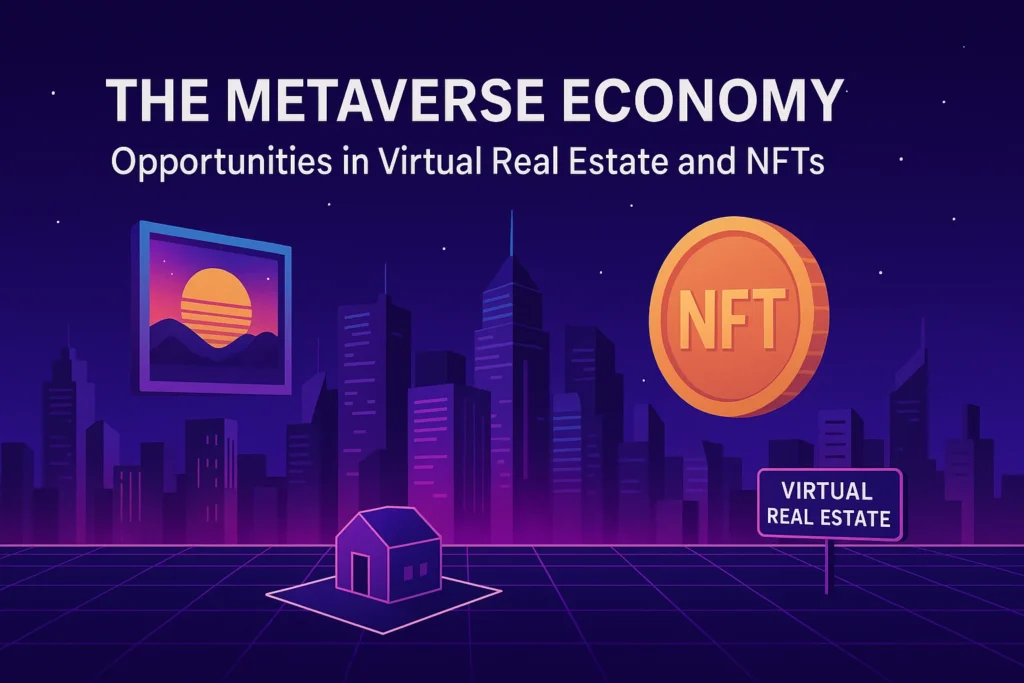Imagine buying a piece of land that doesn’t physically exist—yet sells for millions of dollars. Picture owning a one-of-a-kind digital artwork that trades for more than a Picasso at auction. This isn’t science fiction or some distant future prediction. It’s happening right now in the Metaverse, where a radical new digital economy is taking shape before our eyes.
From celebrities like Snoop Dogg snapping up virtual mansions to Fortnite hosting concerts with millions of attendees, the lines between physical and digital assets are blurring at an astonishing pace. Major corporations, individual investors, and digital creators are all racing to stake their claim in what many believe will be the next evolution of the internet itself.
But how does this virtual economy actually work? What makes pixelated land and digital collectibles so valuable? And most importantly—is this sustainable, or are we witnessing history’s most expensive bubble? Let’s take a deep dive into the mechanics, opportunities, and risks of the burgeoning Metaverse economy.
Understanding the Metaverse: More Than Just Virtual Reality
The Metaverse isn’t a single place or platform—it’s better understood as a network of interconnected 3D virtual worlds where users interact through digital avatars. Unlike traditional video games or social media, these persistent digital spaces allow for true ownership of assets through blockchain technology.
Key platforms driving this revolution include:
- Decentraland: A user-governed virtual world where participants truly own their digital real estate
- The Sandbox: A gaming metaverse where land ownership enables creative monetization
- Meta’s Horizon Worlds: Facebook’s ambitious (if controversial) VR playground
- Cryptovoxels: A blockchain-based virtual world with a strong art scene
What makes these spaces economically significant is their underlying infrastructure. Built on blockchain technology, they enable provable digital scarcity and true asset ownership—two concepts that are revolutionizing how we think about value in digital spaces.
Virtual Real Estate: The Digital Land Grab
In November 2021, a plot of “land” in Decentraland sold for a staggering $2.4 million. Just months later, a virtual yacht club in The Sandbox traded for $650,000. These eye-popping numbers beg the question: Why would anyone pay real money for imaginary property?
The Value Drivers of Digital Land
- Artificial Scarcity: Like Bitcoin, most Metaverse platforms strictly limit the amount of available “land,” creating built-in scarcity.
- Advertising Potential: Major brands like Gucci, Samsung, and HSBC have purchased virtual storefronts to reach digital-native audiences.
- Experiential Commerce: Virtual venues host everything from fashion shows to music festivals, with real economic activity.
- Speculative Investment: Many buyers hope their digital parcels will appreciate like prime physical real estate.
How Virtual Real Estate Generates Income
Early adopters are already monetizing their digital holdings in creative ways:
- Renting out space for virtual events and experiences
- Developing virtual storefronts for e-commerce brands
- Hosting advertising on their digital billboards
- Flipping parcels as values appreciate
The Risks No One Talks About
However, this market carries substantial risks:
- Volatility: Some parcels lost 90% of value during the 2022 crypto winter
- Platform Risk: If a Metaverse platform fails, your investment disappears
- Regulatory Uncertainty: Governments are still figuring out how to tax and regulate virtual assets
- Liquidity Issues: Selling a high-value virtual property isn’t as easy as listing a house
NFTs: The Building Blocks of the Metaverse Economy
Non-Fungible Tokens (NFTs) serve as the deeds and certificates of authenticity for digital assets in the Metaverse. These blockchain-based tokens can represent:
- Virtual real estate deeds
- Digital artwork and collectibles
- Avatar wearables and fashion items
- Game items with real-world value
NFTs That Actually Make Money
While the NFT market has seen spectacular crashes, several use cases show lasting potential:
- Virtual Fashion: Brands like Nike and Dolce & Gabbana sell digital-only clothing that avatars can wear across platforms.
- Gaming Assets: Play-to-earn games like Axie Infinity created entire economies around NFT-based game items.
- Membership Access: NFT holders get exclusive access to events, communities, and virtual spaces.
- Royalty Streams: Creators earn ongoing royalties each time their NFT resells.
The NFT Reality Check
Despite high-profile success stories:
- 90% of NFT collections have lost significant value
- Wash trading (fake sales) distorts market metrics
- Intellectual property rights remain murky
- Environmental concerns persist around blockchain energy use
Who’s Cashing In on the Metaverse Gold Rush?
1. The Early Adopters
- Investors who bought Decentraland parcels for pennies in 2017 now sit on seven-figure assets
- Virtual real estate flippers routinely make 5-10x returns on strategic purchases
2. Corporate Players
- JP Morgan opened the first virtual bank branch in Decentraland
- Walmart filed patents for Metaverse shopping experiences
- Sotheby’s launched a virtual auction house
3. Digital Creators
- 3D artists earn $10,000+ per project designing virtual buildings
- Virtual event planners charge $50,000+ for Metaverse product launches
- Gaming streamers make six figures selling NFT-based merchandise
The Dark Side of the Digital Dream
For all its potential, the Metaverse economy faces significant challenges:
1. The Speculation Problem
Many purchases are purely speculative bets rather than productive investments. When the music stops, not everyone will find a chair.
2. Technological Hurdles
Current VR technology remains clunky and inaccessible to mainstream users. Mass adoption requires better hardware and interfaces.
3. Security Risks
From phishing scams to smart contract exploits, digital asset theft runs rampant in these new ecosystems.
4. Regulatory Headwinds
Governments worldwide are still determining how to classify and tax virtual assets, creating uncertainty.
The Future: Bubble or Revolution?
The trillion-dollar question remains: Is this the foundation of Web3 or history’s most elaborate pyramid scheme?
Bull Case
- Digital natives increasingly value virtual goods and experiences
- Blockchain enables true digital ownership for the first time
- Major corporations are investing billions in infrastructure
Bear Case
- Current valuations appear detached from utility
- Most consumers still don’t understand or care about the Metaverse
- Economic downturns could evaporate speculative demand
Getting Started: How to Participate Wisely
For those interested in exploring opportunities:
- Educate First – Understand blockchain basics before investing
- Start Small – Begin with modest purchases to learn the ecosystems
- Focus on Utility – Prioritize assets with real use cases over pure speculation
- Diversify – Spread risk across different platforms and asset types
- Secure Assets – Use hardware wallets and enable all security features
What’s your take? Is the Metaverse economy the next digital frontier or a disaster waiting to happen? Share your thoughts below! 🚀



